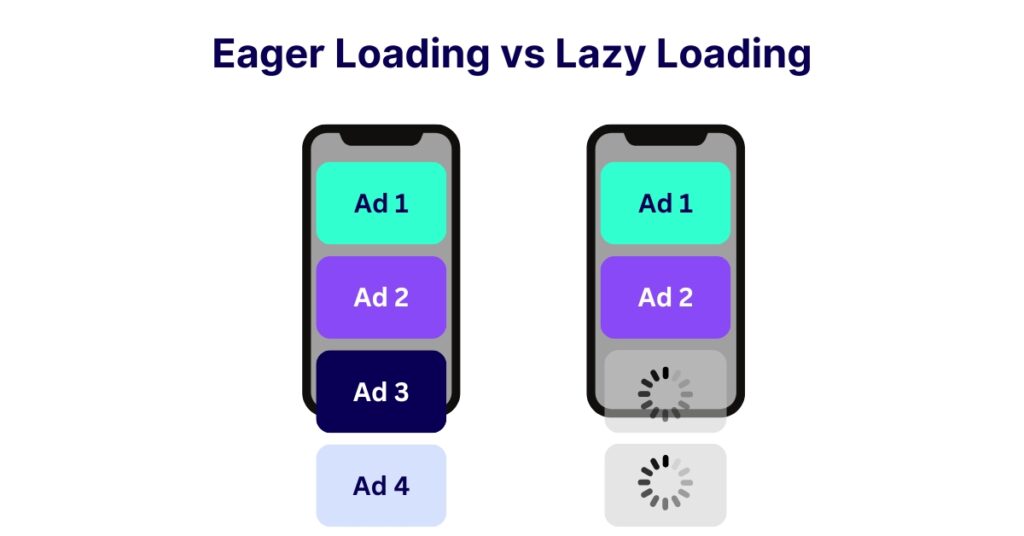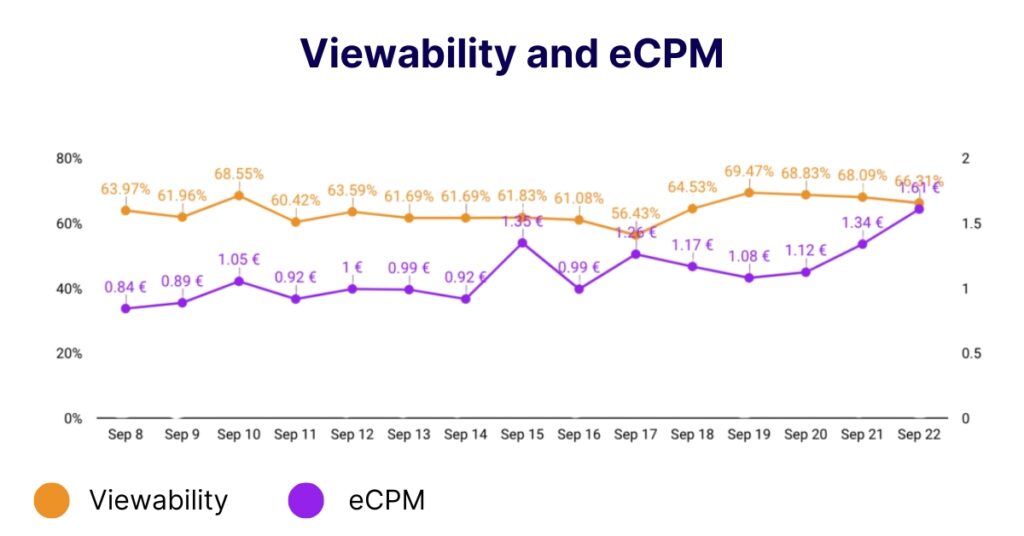Lazy loading is a powerful technique that can significantly increase ad viewability, reduce page latency, and improve UX.
When implemented correctly, it can lead to publishers achieving better ad performance and a higher ad revenue.
Introduction
Lazy loading has become one of the most impactful tools for publishers who want to improve both website performance and ad monetization.
Unlike “eager” loading, where ads are loaded immediately, the browser waits to request certain elements until the user interacts or scrolls near the element. The term “lazy” reflects this delayed, on-demand approach to loading content.

This is implemented to avoid loading numerous ads that users never see, which would significantly reduce viewability and, in turn, lower eCPMs.
It is a common strategy and a recommended UX best practice. In fact, as of May 2024, around 27% of all websites natively used lazy loading, and adoption continued to grow because of its clear benefits for both UX and profitability.
In the competitive digital world, any strategy that speeds up pages, reduces bounce rates, and increases engagement is critical.
Benefits of Lazy Loading
UX
Speed remains one of the most critical ranking and engagement factors for publishers. According to Kanuka Digital’s Research, a 1-second delay in page load time leads to a 7% drop in conversions, 11% fewer page views, and a 16% decrease in customer satisfaction.
From a UX optimization standpoint, pages that load faster feel smoother and keep visitors engaged longer. Longer sessions increase ad exposure, providing more opportunities for publisher ad management teams to deliver ads that align with user behavior.
Lazy loading for ads ensures that only the ads visible to the user are loaded immediately, while those below the fold are delayed. This reduces initial page weight and less JavaScript executing upfront, resulting in faster page loads.
Lazy loading is also very helpful for mobile experiences, as it conserves data usage and speeds up loading for slower, less reliable connections. This is especially useful, as our study done earlier this year revealed that a significant 68.37% of online users access their favorite information sources via mobile.
A quicker, more responsive site enhances user engagement, reduces bounce rates, and increases the likelihood that users see and interact with ads. It also boosts Core Web Vitals and strengthens SEO optimization.
Viewability
Advertisers pay more for inventory that delivers viewable and engaged impressions, and lazy loading aligns perfectly with this market shift.
Effective lazy loading ensures that ad calls are triggered only when impressions are likely to be viewable. This approach prevents wasted impressions and helps ads load seamlessly across devices.
According to our own data, publishers using optimized lazy loading configurations can reach viewability rates of more than 70% across cross-device inventories
The improvement in viewability rates leads to an increase in eCPM (revenue per thousand impressions), as demonstrated by this graph taken from the dashboard of one of our publishers:

In the example above, one can see this relationship, as viewability increased by 10.6%, while eCPMs increased by 18.0% in parallel during the same time period.
Thanks to higher viewability rate, the value of publishers’ inventory increases, which results in higher rates in auctions and increased revenue.
Lazy Loading Best Practices
Key best practices for lazy loading include:
- Exclude above-the-fold ads: You should not implement lazy loading for ads above-the-fold, as you want these to load as quickly as possible,
- Use placeholders for deferred content: Display low-quality images, solid background colors, or skeleton elements while ads load to maintain visual continuity and prevent empty spaces.
- Optimize image formats and sizes: Use modern formats like WebP, compress images, and reduce file sizes before deployment to improve load times and efficiency.
- Test performance, compatibility, and ad delivery across devices and browsers: Lazy loading is not just about delaying ad requests; it is about finding the right moment to load content. Loading too early can waste bandwidth and resources, while loading too late can cause delays for users or missed ad impressions. Publishers should use A/B testing to determine the best strategy for their audience and content type
- Monitor and audit performance: Track metrics for UX optimization, SEO optimization, and revenue yield optimization, and adjust strategies based on results.
Key Takeaways
Lazy loading is a powerful technique for publishers that significantly enhances both UX and SEO optimization. By loading content and ads only when they are needed, it reduces page latency, improves mobile performance, and ensures smoother interactions.
In addition, lazy loading increases ad viewability, as ads are triggered only when they are likely to be seen. This prevents wasted impressions and boots the overall value of your inventory, resulting in higher eCPMs,
To maximize these benefits, publishers should follow best practices such as excluding above-the-fold ads from lazy loading, using placeholders for deferred content, optimizing image formats and sizes, and testing performance across devices and browsers.
Overall, lazy loading provides a strategic advantage by balancing faster site performance with effective ad monetization. It supports both revenue yield optimization and efficient programmatic advertising management, making it a must-have tool for publishers.
FAQs
Lazy loading defers non-essential resources, such as images or scripts, until users scroll near them or interact with them.
Lazy loading improves website performance by reducing page load times, conserving bandwidth, and enhancing the mobile experience. It also increases user engagement and supports SEO optimization, as search engines favor faster-loading pages.
Lazy loading helps in ad monetization by ensuring that ads are only loaded when they are actually visible to the user. This prevents wasted impressions from ads that never appear on the screen, improves viewability metrics, and increases the likelihood of ad interactions, ultimately maximizing revenue.






